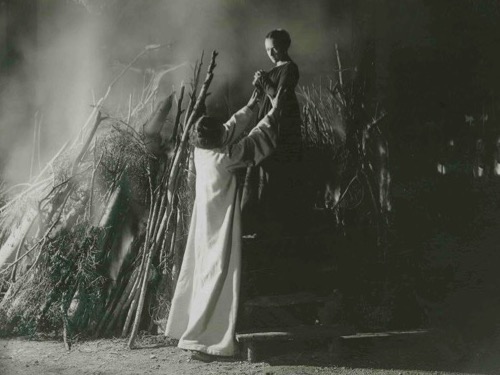VEM DÖMER?
(La prova del fuoco/Love’s Crucible)
Victor Sjöström (SE 1922)
In a Renaissance city, Ursula is trapped in a loveless marriage with Master Anton, an old sculptor. Anton, who has a weak heart, idolizes his wife and uses her as the model for a figure of the Madonna, but she loves Bertram, the young son of her next-door neighbour, the mayor of the town. Ursula buys a deadly poison from a mendicant friar peddling medicines, but the friar surreptitiously replaces the poison with a harmless concoction. In a mirror, Anton sees Ursula pour poison into his cup and is so shocked that he has a seizure and dies. Ursula is suspected of murder, but the friar reveals that there could not have been poison in the cup. Then the great crucifix in the cathedral weeps tears of blood, arousing suspicions once again, and the crowd demands that Ursula be submitted to the judgment of God, a trial by fire.
A film of extraordinary visual beauty, Love’s Crucible has never held the canonical status of Sjöström’s better-known films, despite being known as a film that brought his directorial skills to Hollywood’s attention, leading to his American career two years later, and also despite the similar way it presents an unsparing, psychologically profound examination of marital hatred, guilt, and atonement wrapped inside an atmosphere of legend, old tales, and supernatural visitation. The story takes place in the Catholic south and is shot largely on (vast) studio sets, so it lacks the location shooting and Nordic settings of Sjöström’s more famous works. However, a connection to how nature takes an active part and interferes with the plot of several more famous “Golden Age” films can be found in how the use of fire – one of the classical elements of nature – is essential to the film’s conclusion.
Another notable difference to the central “Golden Age” films is that Love’s Crucible is not based on any novel, but it still has literary credentials: it was based on a “film short story” by the writer Hjalmar Bergman (1883-1931), a tale written as a film treatment, conceived and written in Florence in February 1921. Bergman had earlier written an ambitious historical novel about the 15th-century Dominican friar and Florentine leader Savonarola, so the film’s setting is probably largely Italian in inspiration, even if the film leaves the location vague, and the names of many of the characters are not Italian. The intertitles employ an archaic style, evoking the storytelling style of medieval chronicles; this comes straight out of Bergman’s story, which the film follows very closely.
Contemporary reviewers criticized it for being “artificial” and “lacking in soul,” and these complaints were repeated by some later historians of the Swedish silent cinema. The film’s critical and commercial failure has too-readily been linked to its supposed lack of specifically Swedish authenticity and heart, the Italianate, distinctly Catholic milieu obscuring the many continuities with earlier successes. While the weeping crucifixes and Christ-visions of this film are just as much realizations of the characters’ legend-filled world-view as the peasant paradise of The Sons of Ingmar (Ingmarssönerna, 1919) and the death-cart of The Phantom Carriage (Körkarlen, 1921), they may have sparked the uneasy suspicion in some critics that they were meant to preach rather than portray a superstitious religiosity. To do so, however, would be to underestimate the sophistication of Sjöström’s filmmaking. The evident artistry of the film – every shot is exactingly composed – goes against the myth of Sjöström as an instinctive artist, a rough-hewn naïf similar to the good-hearted peasants he sometimes played on screen. With its sumptuous renaissance setting, its vast sets, and its exquisitely crafted visuals, realized through the efforts of master cinematographer Julius Jaenzon, Love’s Crucible is a self-consciously masterful display of cinematic art and technique.
The print A duplicate negative was made from a nitrate positive source in 1969. The viewing print was struck from this negative the same year.
Magnus Rosborn, Casper Tybjerg

scen: Hjalmar Bergman, Victor Sjöström.
photog: Julius Jaenzon.
scg/des: Axel Esbensen, Alexander Bakó.
cast: Jenny Hasselqvist (Ursula), Ivan Hedqvist (suo marito/Master Anton, her husband), Gösta Ekman (Bertram), Tore Svennberg (il sindaco, padre di Bertram/Bertram’s father, the mayor), Waldemar Wohlström (il monaco/the friar), Knut Lindroth (il priore/the prior), Nils Asther, Paul Seelig (apprendisti/Master Anton’s apprentices).
prod: AB Svensk Filmindustri.
v.c./censor date: 12.12.1921.
uscita/rel: 01.01.1922.
copia/copy: 35mm, 1787 m., 87′ (18 fps); did/titles: SWE.
fonte/source: Svenska Filminstitutet, Stockholm.


 Italiano
Italiano